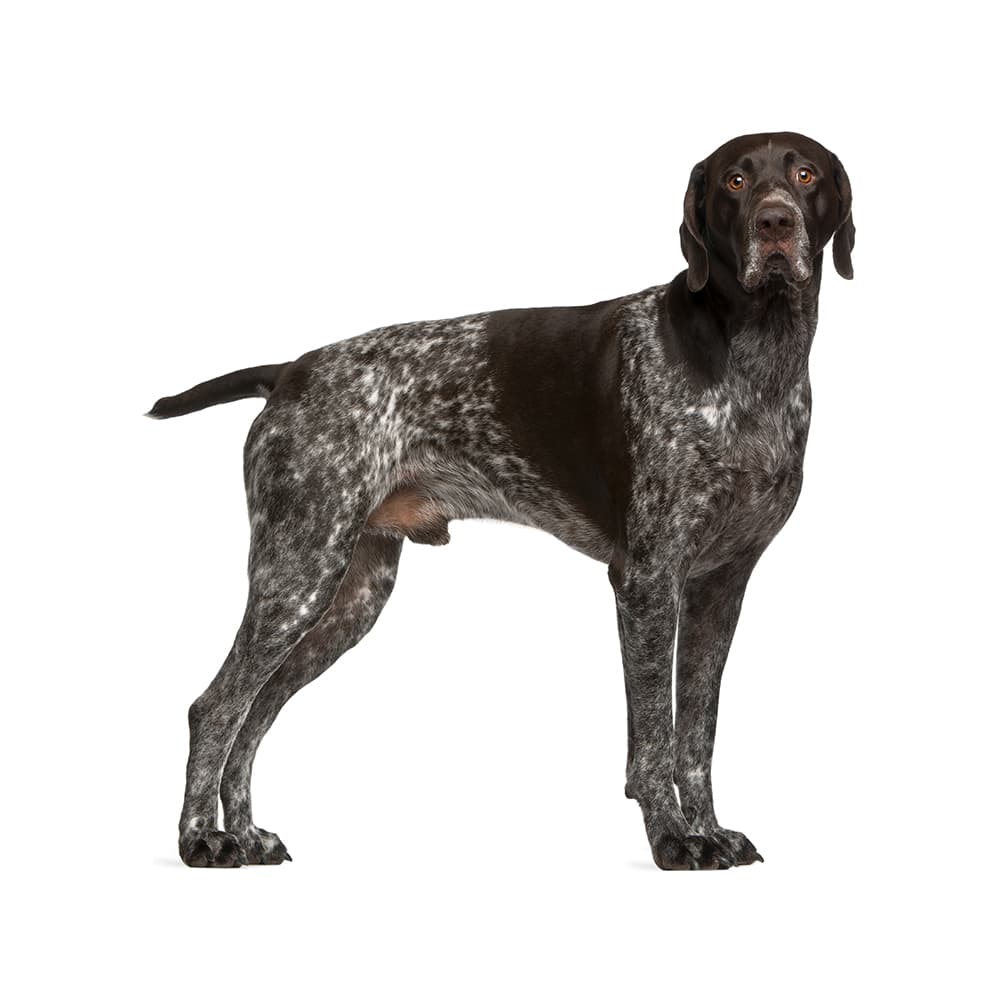Basepaws analyzes this breed as part of a group of other breeds.


Basepaws analyzes this breed as part of a group of other breeds.


Basepaws analyzes this breed as part of a group that also includes German Shorthaired Pointer, German Wirehaired Pointer.
Despite being distinct in characteristics and origin, some pairs or groups of breeds lack the number of genetic differences required to distinguish these populations from one another, particularly when only a subset of these differences are inherited by a mixed breed dog. As we continue to expand our breed database, we aim to increase the resolution of our ancestry algorithm such that differentiating between increasingly specific ancestral sources becomes possible.

The German Shorthaired Pointer (GSP) originated in Germany in the mid to late 19th century. Breeders aimed to create a versatile hunting dog that was equally proficient on land and water. They bred various German tracking hounds with English Pointers, Spanish Pointers, and others to achieve the desired traits. The GSP is known for its skill in hunting, retrieving, and pointing at both small and big game. It was first recognized by the American Kennel Club (AKC) in 1930.
German Shorthair Pointers can suffer from achromatopsia, acral mutilation syndrome, amaurotic idiocy, brachygnathism, cataracts, chronic inflammatory hepatic disease, cruciate ligament disease, cutaneous lupus erythematosus, deafness, entropion, epidermolysis bullosa (junctional), everted cartilage of third eyelid, Factor I (fibrinogen) deficiency, Factor VII deficiency, Factor VIII deficiency (hemophilia A), Factor XII deficiency, gastric dilation/volvulus, GM-2 gangliosidosis, hemivertebra, hip dysplasia, immune-mediated polyarthritis, intersex (gonadal), Lupus erythematosus (discoid), Lupus erythematosus
(exfoliative cutaneous), lymphedema, meningoencephalitis, muscular dystrophy, myasthenia gravis, osteochondritis dissecans (shoulder), overshot jaw, panosteitis, persistent hyaloid artery, prognathism, recurrent flank alopecia, sensory neuropathy, subaortic stenosis, von
Willebrand disease (Type II). Hip elbow and ophthalmologist evaluations are recommended along with cardiac exams. Genetic testing is recommended, including for the following additional conditions: hyperuricosoria, degenerative myelopathy, and progressive rod-cone degeneration.
The German Shorthair Pointer (GSP) has an energetic and friendly nature. They are intelligent, eager to please, and are known to form strong bonds with their families. This breed requires ample physical exercise and mental stimulation, as they can become destructive when bored. Running, agility games, or fetching are great ways to exercise both their body and mind. Their high level of intelligence makes them highly trainable, but they can be independent and stubborn at times. They are typically good with children and other dogs, but their hunting instincts can make them chase smaller pets. German Shorthair Pointers like to be around people, and don’t like to be left alone for long periods of time.
A canine genetic lineage is a group of individuals or entire breeds that descended from common ancestors predating modern breed formation. Often these lineages are associated with a ‘type’ of dog with a unique historical working role and associated behaviors (e.g., herding, scent hunting, etc.).
The Pointer-Spaniel lineage encompasses both pointer and spaniel breeds. They were both bred for their specialized hunting abilities in Europe. Pointers locate game and freeze in a stance, called “pointing”, to indicate to their hunter that birds are close by. Spaniels were bred to find game in underbrush and retrieve it. Both pointer and spaniel breeds were bred to enhance their strong senses, trainability, and endurance as these are advantageous in a hunting partner. Spaniels and pointers are known for their strong work ethic, ability to work closely with humans and agility. These dogs’ ability to work closely with their hunters makes them an asset during a hunt because they follow direction well and know how their hunters want them to proceed.
Example breeds with ancestry from this lineage include English Cocker Spaniel, Irish Red Setter, and German Shorthaired Pointer.
Prince Albrecht zu Solms-Braunfels is credited as a key player in the early development of the German Shorthaired Pointer.
In Germany, before a German Shorthaired Pointer can be bred, they must pass a rigorous test of their hunting abilities to ensure the continuation of the breed's skills.
The German Shorthaired Pointer was featured in the U.S. postal service's "Working Dogs" stamps series in 2012.
https://www.fci.be/Nomenclature/Standards/119g07-en.pdf https://www.akc.org/dog-breeds/german-shorthaired-pointer/
https://www.ukcdogs.com/german-shorthaired-pointer https://www.petmd.com/dog/breeds/c_dg_german_shorthaired_pointer
Recommended by top vets with decades of experience
21 breeds
64 genetic health markers
50 genetic trait markers
